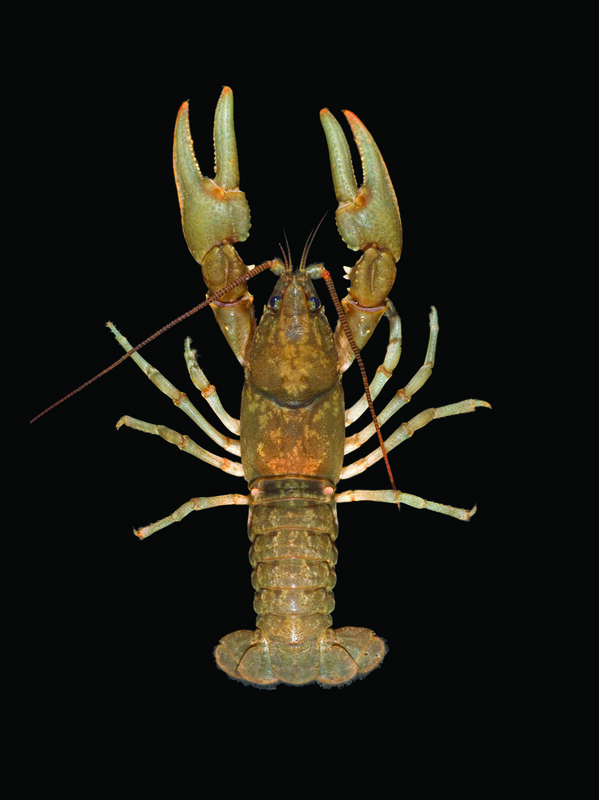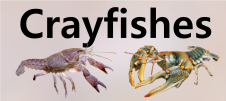







Loading profile. Please wait . . .
Cambarus parrishi Hobbs, 1981
Hiwassee Headwater Crayfish




Federal Protection: No US federal protection
State Protection: Endangered
Global Rank: G2
State Rank: S1
Element Locations Tracked in Biotics: Yes
SWAP 2015 Species of Greatest Conservation Need (SGCN): Yes
SWAP 2025 Species of Greatest Conservation Need (SGCN): Yes
2025 SGCN Priority Tier: Highest Conservation Concern
Element Occurrences (EOs) in Georgia: 8
Habitat Summary for element in Georgia: Rocky areas between riffles in clear headwater streams
The overall color of the Hiwassee Headwater Crayfish is a brownish-green with dark mottling. The areola is wide and the rostrum gradually narrows anteriorly and has two very small marginal tubercles. This species reaches a maximum total body length of about 75 mm (3 inches).
The Hiwassee Headwater Crayfish occurs with the similar Common Crayfish, Cambarus bartonii. The rostrum of the latter is short and tapers abruptly. The rostrum of the Hiwassee Headwater Crayfish tapers, but is longer and has small marginal tubercles. Furthermore, the claws of the Hiwassee Headwater Crayfish have two rows of tubercles along the mesial margin of the palm, while those of the Common Crayfish have a single row.
This species is a stream dweller and is usually collected from beneath large rocks in flowing water, usually near riffles. Occasionally they can be found in packs of leaf litter.
No studies of the Hiwassee Headwater Crayfish are known. Crayfishes are considered opportunistic omnivores and are likely to feed on live and decaying vegetation, aquatic insect larvae, small fishes, and dead animal matter.
Stream dwelling crayfishes typically hide during the day and come out at night to feed. Reproduction usually occurs during the spring and fall, but males in reproductive condition may be found at any time during the year. When female crayfish are ready to lay eggs, they usually find a secure hiding place and hence are rarely encountered. When the eggs are released, the female attaches them to her swimmerets and is said to be “in berry.” Upon hatching, the juvenile crayfish are attached to the mother by a thread. After the juveniles molt for the second time, they are free of the mother, but stay close and will hold on to her for some time. Eventually they move off on their own. Crayfishes molt 6 or 7 times during their first year of life and most are probably able to reproduce by the end of that year. They molt once or twice a year for the remainder of their lives and live about 3 years. Male Hiwassee Headwater Crayfish in reproductive condition have been collected in January, April, May, August, October, and November and females carrying eggs were found in April and June. Numbers of eggs ranged from 38–112 with diameters of 2.2–2.6 mm. The smallest breeding male is about 50 mm (2 in) and the smallest female with eggs about 53 mm (2.1 in) in length (Hobbs 1981).
Since this species is usually found in flowing water, it is most easily collected by holding a net perpendicular to the current downstream of a large rock, then lifting the rock and disturbing the substrate beneath it. If a crayfish is hiding underneath the rock, it will likely move into the net. Shocking downstream into a seine net with a backpack electroshocker is also effective. Collections in spring or fall are more likely to produce males in reproductive condition, which can be helpful with identifications.
The Hiwassee Headwater Crayfish is known only from the extreme headwater portions of the Hiwassee River system in North Carolina and Georgia in the Blue Ridge physiographic province (Davis et al. 2015, Hobbs 1989, Simmons and Fraley 2010). In Georgia, the species is restricted to the Hiwassee River system upstream of Hiawassee in Towns County.
The small range of this species and the high development rates within that range are significant threats to the Hiwassee Headwater Crayfish. Residential growth can lead to an increase in stormwater runoff which may negatively alter water quality. Heavy sedimentation resulting from poor development and land management practices may cover substrates and other daytime hiding places on which crayfishes rely to avoid predation. The introduction of non-native crayfishes is a threat to all native crayfishes.
| Threat 1 | Threat 2 | Threat 3 | |
|---|---|---|---|
| General Threat | Natural system modifications | Invasive & other problematic species, genes & diseases | Climate change & severe weather |
| Specific Threat | Dams & water management/use | Invasive non-native/alien species/diseases | Habitat shifting & alteration |
Despite the small range size of this species in Georgia, its populations are thought to be stable at this time. Most of the populations occur on US Forest Service land and are somewhat protected.
Conserving populations of the Hiwassee Headwater Crayfish will require general watershed level protection measures, including the protection of riparian zones, control of sediment and nutrient runoff from farms and construction sites, and limiting the amount of impervious cover (e.g., pavement) within occupied watersheds. Non-native crayfishes should never be used for bait. Instead, anglers should use crayfishes collected from the river system they will be fishing in and should never release unused bait crayfish back into Georgia waters.
Davis. J., K. Cash, B. Henry, and S. Weaver. 2015. Associated habitat and population characteristics of the Hiwassee Headwater Crayfish, Cambarus parrishi, in North Georgia. Freshwater Crayfish 21:83–93.
Hobbs, H.H., Jr. 1981. The crayfishes of Georgia. Smithsonian Contributions to Zoology 318:1–549.
Hobbs, H.H., Jr. 1989. An illustrated checklist of the American crayfishes (Decapoda: Astacidae, Cambaridae, and Parastacidae). Smithsonian Contributions to Zoology 480:1–236.
Simmons, J.W. and S.J. Fraley. 2010. Distribution, status, and life-history observations of crayfishes in western North Carolina. Southeastern Naturalist 9 (Special Issue 3):79–126.
Skelton, C.E. 2016. Status Assessment for 14 Crayfish Petitioned for Listing. Final Report. United States Fish and Wildlife Service, Athens, GA. 71 pp.
Taylor, C.A., G.A. Schuster, J.E. Cooper, R.J. DiStefano, A.G. Eversole, P. Hamr, H.H. Hobbs III, H.W. Robison, C.E. Skelton, and R.F. Thoma. 2007. A reassessment of the conservation status of crayfishes of the United States and Canada after 10+ years of increased awareness. Fisheries 32:372–389.
Christopher E. Skelton
C. Skelton, 2008: original account
C. Skelton, January 2019: general update of account.